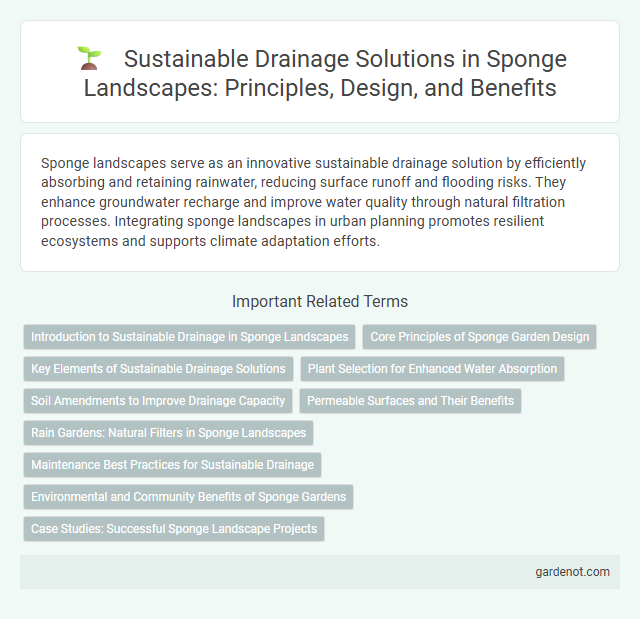Sponge landscapes serve as an innovative sustainable drainage solution by efficiently absorbing and retaining rainwater, reducing surface runoff and flooding risks. They enhance groundwater recharge and improve water quality through natural filtration processes. Integrating sponge landscapes in urban planning promotes resilient ecosystems and supports climate adaptation efforts.
Introduction to Sustainable Drainage in Sponge Landscapes
Sustainable drainage solutions in sponge landscapes manage surface water by mimicking natural hydrological processes, reducing flood risk and improving water quality. These systems integrate permeable soils, vegetation, and natural storage areas to capture, slow, and filter runoff before it reaches water bodies. Incorporating bioswales, retention ponds, and green roofs enhances urban resilience while supporting biodiversity and groundwater recharge.
Core Principles of Sponge Garden Design
Sponge garden design centers on core principles such as maximizing rainwater infiltration, enhancing soil permeability, and promoting natural water retention to reduce runoff and prevent flooding. Incorporating native, drought-resistant plants and permeable surfaces supports sustainable drainage by absorbing and filtering stormwater efficiently. The integration of contouring landforms and strategically placed rain gardens further optimizes water capture and groundwater recharge within urban landscapes.
Key Elements of Sustainable Drainage Solutions
Key elements of Sustainable Drainage Solutions (SuDS) in sponge landscapes include infiltration practices like permeable pavements and infiltration basins that enhance groundwater recharge. Vegetation-based features such as swales, retention ponds, and bio-retention cells manage surface water runoff, reduce pollution, and support biodiversity. These components collectively mitigate flooding, improve water quality, and promote natural hydrological cycles within urban and rural environments.
Plant Selection for Enhanced Water Absorption
Selecting hydrophilic plants with deep root systems significantly improves water infiltration and retention in sponge landscape designs. Native species such as carex, juncus, and menyanthes optimize soil structure, reducing runoff and enhancing groundwater recharge. Incorporating diverse plant varieties with high transpiration rates supports sustainable drainage by maintaining soil moisture balance and preventing erosion.
Soil Amendments to Improve Drainage Capacity
Soil amendments significantly enhance drainage capacity by increasing soil porosity and water infiltration rates in sponge landscapes. Organic materials such as compost and biochar improve soil structure, promote microbial activity, and reduce surface runoff, effectively managing stormwater. Incorporating these amendments supports sustainable drainage solutions by optimizing water retention and minimizing erosion risks.
Permeable Surfaces and Their Benefits
Permeable surfaces in sponge landscapes enhance sustainable drainage by allowing water to infiltrate the ground, reducing surface runoff and minimizing flood risks. These surfaces, made from materials like permeable concrete, porous asphalt, or interlocking pavers, promote groundwater recharge and filter pollutants, improving water quality. Implementing permeable surfaces supports urban resilience by managing stormwater naturally and mitigating heat island effects.
Rain Gardens: Natural Filters in Sponge Landscapes
Rain gardens function as natural filters within sponge landscapes, capturing and absorbing stormwater runoff to reduce flooding and improve water quality. These sustainable drainage solutions utilize native vegetation and engineered soils to enhance infiltration and remove pollutants, promoting groundwater recharge. Integrating rain gardens in urban and suburban areas supports biodiversity while mitigating the impacts of surface water runoff.
Maintenance Best Practices for Sustainable Drainage
Regular inspection and cleaning of permeable surfaces and infiltration devices ensure optimal functionality of sustainable drainage systems (SuDS). Removing debris and sediment buildup prevents blockages and maintains effective water flow, reducing flood risk and promoting groundwater recharge. Implementing a scheduled maintenance plan using specialized equipment extends system lifespan and supports long-term environmental benefits.
Environmental and Community Benefits of Sponge Gardens
Sponge gardens serve as a sustainable drainage solution by effectively managing stormwater runoff through natural absorption and filtration processes, reducing the risk of urban flooding. These gardens enhance local biodiversity by providing habitats for pollinators and wildlife, contributing to healthier ecosystems. Communities benefit from improved air quality, reduced heat island effects, and increased green spaces that promote social well-being and resilience against climate change.
Case Studies: Successful Sponge Landscape Projects
Case studies of successful sponge landscape projects showcase effective sustainable drainage solutions that enhance urban resilience by managing stormwater through natural infiltration and retention. Key examples include the Tianjin Sponge City initiative in China, which reduced surface runoff by 70% through permeable pavements and green roofs, and the Rotterdam Water Plaza in the Netherlands, featuring multifunctional water plazas that temporarily store excess rainwater. These projects demonstrate significant improvements in flood control, groundwater recharge, and local biodiversity within urban environments.
Sustainable drainage solution Infographic

 gardenot.com
gardenot.com